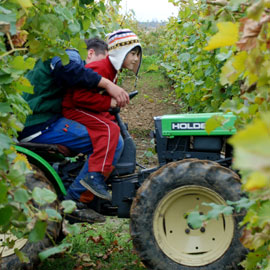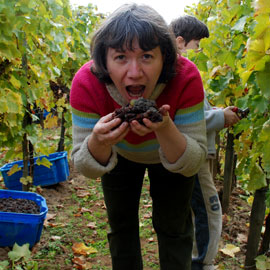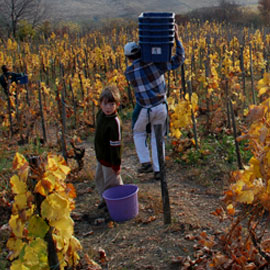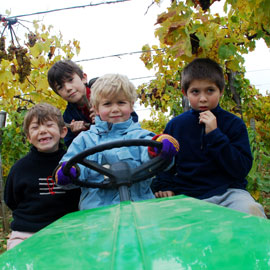



2000
The year was extremely early. The grapes were very concentrated and brought notes of honey and dried apricots into the wines. A superb vintage, with loads of aszú grapes. It was a real trigger: the vintage of all possible !! It’s the year we started our winery and wine production.
2001
Very nice vintage, a little bit late, with botrytis. The wines were full of spicy notes. The huge acidity assures a long life in bottle.
2002
One of those rare vintages where we payed the bill of our decision : we waited too long to harvest. Not a single glass of wine was produced in our cellar. A very rainy year (but dry in the cellar !!).
2003
The vintage was easy. Ideal weather during the harvest, beautiful maturities. Fantastic wines, very smooth, delicious to drink today. A punctual vintage picked up on time.
2004
It was a very late vintage, saved just before winter. From the 7th November, we picked up bunches full of aszú berries. It was still time to look for motivated people to harvest this treasure. We finished under the snow… A very stressfull vintage, but so fascinating !
2005
2005 is this type of year that you have to go and fetch. But it’s worth it. Very late again, the vintage gave us straight and delicate wines with a strong acidity that brings sharpness and neatness.
2006
This year gave us the opportunity to show how balanced can be the Tokaji sweet wines as far as sugar and acidity are concerned. When you taste our Tokaji Aszú 2006, you can feel the sugar, but you’re not sure it is sugar ! 2006 was produced in a very tiny quantity. If you’re a collector, it’s a wine you should’nt miss.
2007
Early flowering, serious drop of acidity in August that forced us to ask ourselves : do we harvest or not ? Finally, we harvested around the 15th October. The terroir of Tokaj expresses itself even in contemporary weather conditions.
2008
Far from the extremes, serenity and appeasement illustrate the vintage. We got a huge amount of grapes of very good quality. The harvest lasted until 10th November. The juices were neither too sweet nor too acid, we could do very long macerations and very nice extractions that reflect in the dry extract.
2009
August and September didn’t see a drop of rain, causing a drought in the region. By 20th October, the dry whites were in the cellar, but the aszù crop was still outside. The first rain arrived on 11th October, we harvested some grapes until the 17th. On 2nd November we had a frost in the morning, two days at -10 ° C. The whole game was over. Result: 100 liters to taste. That’s all folks !!
2010
The year was a disaster, with floods, diseases in the vineyards. The few remaining grapes were eaten by deers, wild boars and birds. We made a single cask of wine. 2009 and 2010 are two catastrophic vintages one after the other.
2011
The Esszencia remained in the aszú berries (it did not flow as usual). The berries macerated for three weeks in a finished wine after the harvest. Everything was pressed but the juice did not want to ferment. He finally decided to move on in September 2013 and finished its fermentation in December 2013. We did only one racking.
2012
It was an early vintage. Everyone picked up early, but a lot of grapes were taken away in September because of a lack of wines in Europe. Those from Tokaj have left the region. We personnaly made dry szamorodni, and not one liter of sweet wine. Moreover, it was our first year of dry furmint, in the cru Szent Tamás. The grapes were beautiful.
2013
It was a great year for aszú berries. For us, it was the second vintage of dry furmint in the cru Szent Tamás. Same place, same winemaker, same winemaking process, but harvested … a month later, on 8th October 2013 ! This is the proof that the date of the harvest is essential to capture the perfect balance between alcohol, sugar, acidity and freshness.
2014
It was a difficult year, where every step was counted. We picked the berries one by one except that it was not aszú berries … but healthy grapes ! Therefore many sacrifices were made for this handpicked cuvée, but it’s worth it ! Once again, the terroir expresses itself beautifully and jumps over the climatic conditions.
2015
It was a perfect vintage for dry wines. Until mid-October, the weather gave to the grapes enough sugar and acidity. The harvest was healthy and rich. A good year to show a typical dry furmint from our cru Határi.
2016
The vintage was promising. Beautiful grapes were picked to make dry furmint of high quality. Then we waited for aszú. Some aszú berries did show up but we had to be quick because a torrential rain washed out all our hopes, earlier than in 2015. The weather is definitly capricious.
2017
Rare enough to be underlined and framed ! 2017 was an ideal vintage for all categories of wine. As far as the weather’s concerned, it was a succession of good auguries: perfect rain, perfect sun, hot summer, water when necessary, sun when necessary, fog when necessary, snow in winter. .. IDEAL, from 1rst January to 31rst December. Results: magnificent dry wines, splendid sweet wines. The perfect vintage that justifies all other efforts.
2018
After the perfect balance of the 2017, this 2018 vintage is a really difficult one. Less than 100 mm of rain in a very concentrated period. A very hot year with an early, much to early growing period : we had to harvest in the middle of August ! We made only dry wines botrytis free. Very proud of the result.
2019
That is a present of God after the 2018. No extremes, only quiet and smooth conditions to work properly. It was a very appreciated vintage indeed !
